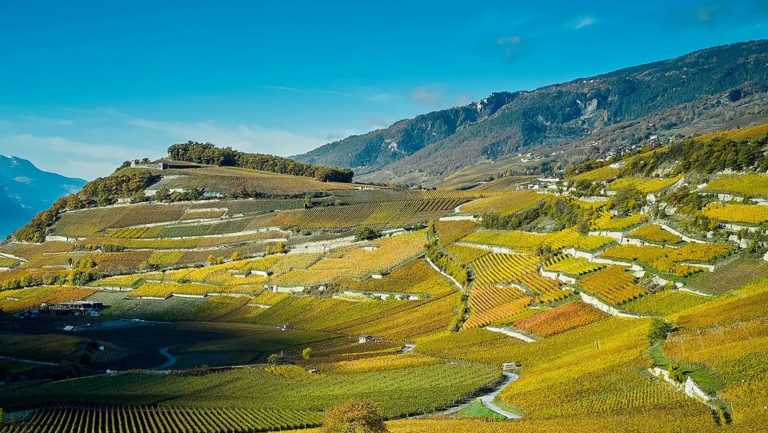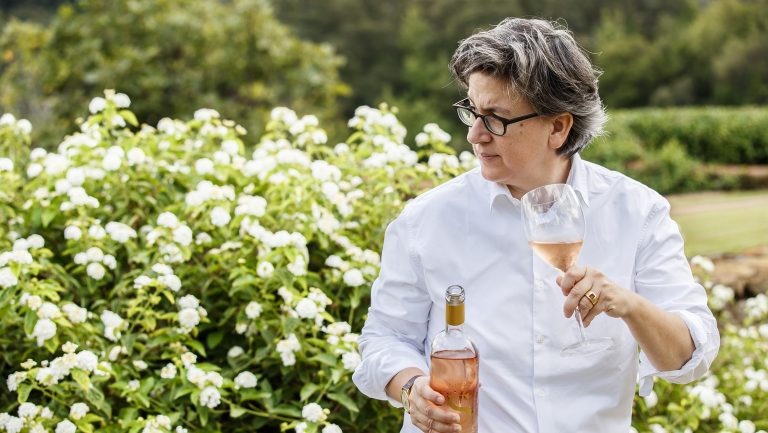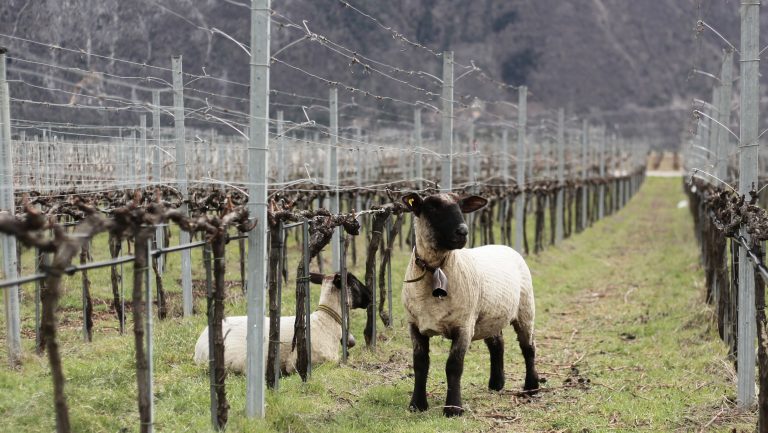Despite sharing borders with such viticultural heavyweights as France, Italy, Germany, and Austria, and boasting an equally storied wine culture, Switzerland’s reputation as a purveyor of cheese, chocolate, and complex financial instruments has always eclipsed its standing as a producer of fine wine.
A tiny Alpine nation whose wine industry is composed of thousands of small, independent growers who earn their livelihoods tending the perilously steep, low-yielding slopes of its six unique growing regions, Switzerland ekes out barely over one million hectoliters of wine per year. Compared to Italy’s 50 million hectoliters, or even Germany’s eight million, that amounts to a minuscule quantity—less than half the amount necessary to satisfy domestic demand. As a result, the Swiss maintain a time-honored tradition of consuming the bulk of their wine within their own borders, with fewer than two percent of the country’s output earmarked for export.
It should therefore come as no surprise that Swiss wine has never commanded more than a marginal presence in the U.S. market. According to Neal Rosenthal, the founder of Rosenthal Wine Merchant, one of the first U.S. importers to introduce estate-grown, small-production Swiss wines to American audiences, several related factors have conspired to perpetuate this chronic lack of visibility—not least of all, the wines’ scale of production, unfamiliarity, and price.

Don’t miss the latest drinks industry news and insights. Sign up for our award-winning newsletters and get insider intel, resources, and trends delivered to your inbox every week.
“Our Swiss wines are truly spectacular, but no one ever really paid consistent attention to them,” says Rosenthal. “For one, thanks to the strength of the Swiss franc, Swiss wine tends to be expensive. Second, most of the vineyards are planted on such steep terraces that you need to work them manually, and the yields are extremely low. Finally, you have all these unknown local varieties that no one has ever heard of, so there’s a great deal of education involved.”

There’s a reason, however, why he never gave up on Switzerland. Whether the nuanced complexity of a classic Chasselas or the chiseled purity of a brambly Cornalin or Humagne Rouge, the country’s greatest wines unquestionably stand toe-to-toe with the world’s finest, including those of its illustrious neighbors. As Rosenthal puts it, “It’s an uphill battle, but we stick with it because we believe in the wines.”
Increasingly, he’s not alone in that judgment. Within the span of just a few years, it has been possible to detect, if not a full-blown boom, then at least a noticeable uptick of industry interest in Switzerland. As a new crop of boutique importers scours the country in search of the next generation of winemaking talent—a group that includes Polaner Selections, Schatzi Wines, Convivium Imports, and European Cellars, among others—the bottles that have emerged from this quest have finally started to claim their place on wine lists and retail shelves across the U.S. This evolution is helping to flesh out a greater understanding of Switzerland’s historic importance as a winemaking nation, offering stateside drinkers a taste of the country’s full depth and diversity for the first time.
The New Class of Swiss Wine
This process of discovery comes at a critical inflection point in the trajectory of the Swiss wine industry. With little financial incentive to sell their wines abroad, the country’s producers never needed to look beyond their own backyards to seek out business. While that remains as true today as it was for generations past, a small but growing number of winemakers have come to view that insularity not as an advantage but a liability.
“We have been spoiled by the fact that we don’t need to export,” says Chandra Kurt, one of Switzerland’s leading wine writers, who also produces a vibrant range of Swiss wines under her own name. “Because the competition has been missing, we’ve been a bit too content to rest in our comfort zone, but over the past five to seven years that has been rapidly changing.”

Breaking with tradition, Kurt joins an expanding roster of producers who have made it their mission to demonstrate Switzerland’s potential to the rest of the world. That list includes legends such as Marie-Thérèse Chappaz and Domaine de Beudon—Switzerland’s great pioneers of biodynamic farming—Domaine de la Colombe’s Raymond Paccot, Domaine Jean-René Germanier, and the Vaud’s Louis Bovard, as well as rising stars like Martin Donatsch (based in the tiny valley of Bündner Herrschaft), the Argau’s Tom Litwan, and Hans Peter-Schmidt of the fiercely naturalist Mythopia project, to name just a few. In many cases, such as that of Catherine Cruchon of the Vaud’s Domaine Henri Cruchon, they’re taking the reins of their family estates with the goal of converting to organic or biodynamic farming and embracing a more minimalistic approach in the cellar.
Fortunately, their work has begun attracting the attention of individuals like Daniel Hess, the Swiss-born, Los Angeles-based proprietor of Convivium Imports. Founded in 2020, the company has made Switzerland’s budding natural wine scene a major part of its focus. “There is this generational shift taking place right now, and it’s impossible to ignore,” says Hess. “But only if you’re spending time in Switzerland, driving around and getting to know the scene, will you get pointed to where it’s all happening. Every time I go back, I find new producers and labels popping up all over the country.”
Many of the examples he’s introducing to West Coast drinkers display an intimate awareness of the trends currently driving the wine world’s progressive agenda. Consider, for example, winemaker Markus Ruch’s Amphore Klettgau, a savory, skin-fermented, take on the Müller-Thurgau grape, grown in the gravelly, limestone soils of Klettgau, just across the German border. Organically farmed, spontaneously fermented, and bottled sans sulfur, it’s the exact sort of “lo-fi” fare one would expect to encounter in the natural wine bars of Paris or Copenhagen—all without sacrificing the classical elegance and transparency that represent Switzerland’s calling card.
That Alpine Feeling
To anyone familiar with the latest evolutions in consumer taste, Switzerland’s growing recognition will seem long overdue. With a diverse grab bag of nearly 200 native grapes—from Chasselas, Cornalin, Humagne Rouge, and Petive Arvine to Gamaret, Completer, Müller-Thurgau, Heida, and more—its heroic, high-altitude viticulture, and its increasing embrace of organic farming, Switzerland ticks off all the right boxes to resonate with the current in-crowd of sommeliers and industry tastemakers.
It doesn’t hurt that this very same set of professionals has already gravitated toward the fashionably cool-climate mountain wines of areas such as France’s Jura and Savoie regions, Germany’s Swabia (aka Baden and Württemberg), and Italy’s Valle d’Aosta and Trentino-Alto Adige.

All of these viticultural hot zones share one thing in common: a boundary with Switzerland. Exhibiting the same high-altitude tension between fruit, acid, and vibrant minerality, Swiss wine represents a natural next step for buyers who have already jumped on this Alpine bandwagon. But at the same time, Switzerland’s importance transcends mere fashion. A point of convergence for so many of the world’s great wine cultures—French, Teutonic, and Italian—the country’s own heritage runs just as deep.
This significance isn’t lost on Kevin Pike, the owner of Schatzi Wines, who now includes three Swiss producers in his portfolio. More than a fringe footnote or curiosity, he has come to view the country as one of Europe’s most essential destinations for wine. “What drew me to Switzerland is the fact that it represents the headwaters of the wine regions that I truly love,” he explains. “The Rhine River starts there, and so does the Rhône. So if you’re working your way back to the origins of these massively foundational wine cultures, Switzerland is the endpoint at which you’re going to arrive.”
From this perspective, one of the biggest historical impediments to Switzerland’s viability in the U.S. market no longer appears quite so daunting: the question of cost. While no one would characterize Swiss wine as cheap, few countries deliver such a consistently high level of quality for the money. Victoria James, the wine director and partner at Cote Korean Steakhouse in New York City and Miami, aptly sums up the relevant calculus.
“Maybe Swiss wines are expensive if you’re looking for a $10 bottle, but not when you’re buying for Michelin-starred restaurants here in New York,” she says. “Honestly, we’re talking about this amazing country squeezed in between France, Italy, and Germany. If you’re a sommelier and you’re not paying attention to Switzerland, then what the hell are you doing?”

Dispatch
Sign up for our award-winning newsletter
Don’t miss the latest drinks industry news and insights—delivered to your inbox every week.
Zachary Sussman is a Brooklyn-based wine writer whose work has appeared in Saveur, Wine & Spirits, The World of Fine Wine, Food & Wine, and The Wall Street Journal Magazine, among many others. A regular contributor to Punch, he was formerly selected as the Champagne Louis Roederer Emerging Wine Writer of the Year. He is the author of The Essential Wine Book (2020) and Sparkling Wine for Modern Times (November, 2021) from Ten Speed Press.






